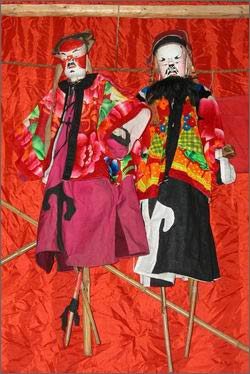 As one of China's performing art contributions to world heritage treasures, Chinese puppetry has a long history. It is noted for its many types of puppets and superb manipulative skill.
As one of China's performing art contributions to world heritage treasures, Chinese puppetry has a long history. It is noted for its many types of puppets and superb manipulative skill.
No truly definitive conclusions have yet been reached on the origin and evolution of Chinese puppetry. However, pottery figurines used in place of slaves as burial objects have been discovered at the Yin Ruins dating from the Shang Dynasty (16th-11th century BC) in Anyang of Henan Province. Wooden figurines used as burial objects appeared during the Spring and Autumn (770-446BC) and Warring States (475-221BC) periods.
In a Western Han (206BC-24AD) tomb at Mawangdui in Changsha Hunan Province, a number of wooden figurines of singers, dancers, and musicians have been unearthed. These were a great improvement on those from previous dynasties in terms of craftsmanship, variety, and modeling. These figurines perhaps represent the earliest Chinese puppets.
Over time, figurines as burial objects evolved into puppets for entertainment on festive occasions.
In 1979, a large wooden figure was discovered at Daishu Village in Laixi County Shandong Province. The figure, 193 centimeters long and fashioned from 13 pieces of wood, has movable joints enabling it to assume a sitting, standing, or kneeling position. Its discovery shows that there was indeed a transitional period between figurines made to pacify the dead and their evolvement into puppets used for amusing people.
The discovery also shows that figurines with movable joints like human beings began to appear, laying a substantial foundation for the birth of Chinese puppetry. Therefore, most experts believe Chinese puppetry originated from burial objects that underwent three stages of development -- from slaves to musicians to animated singers and dancers.
As to when puppets were first used in theatrical performances, experts agree that the art "arose in Han and became popular in the Tang Dynasty (618-907)." According to the History of the Later Han Dynasty, puppets already existed during the Han Dynasty (206BC-220AD). During the Three Kingdoms Period (220-280), a person named Ma Jun used flowing water to manipulate wooden figures to do variety acts mimicking human performance.
